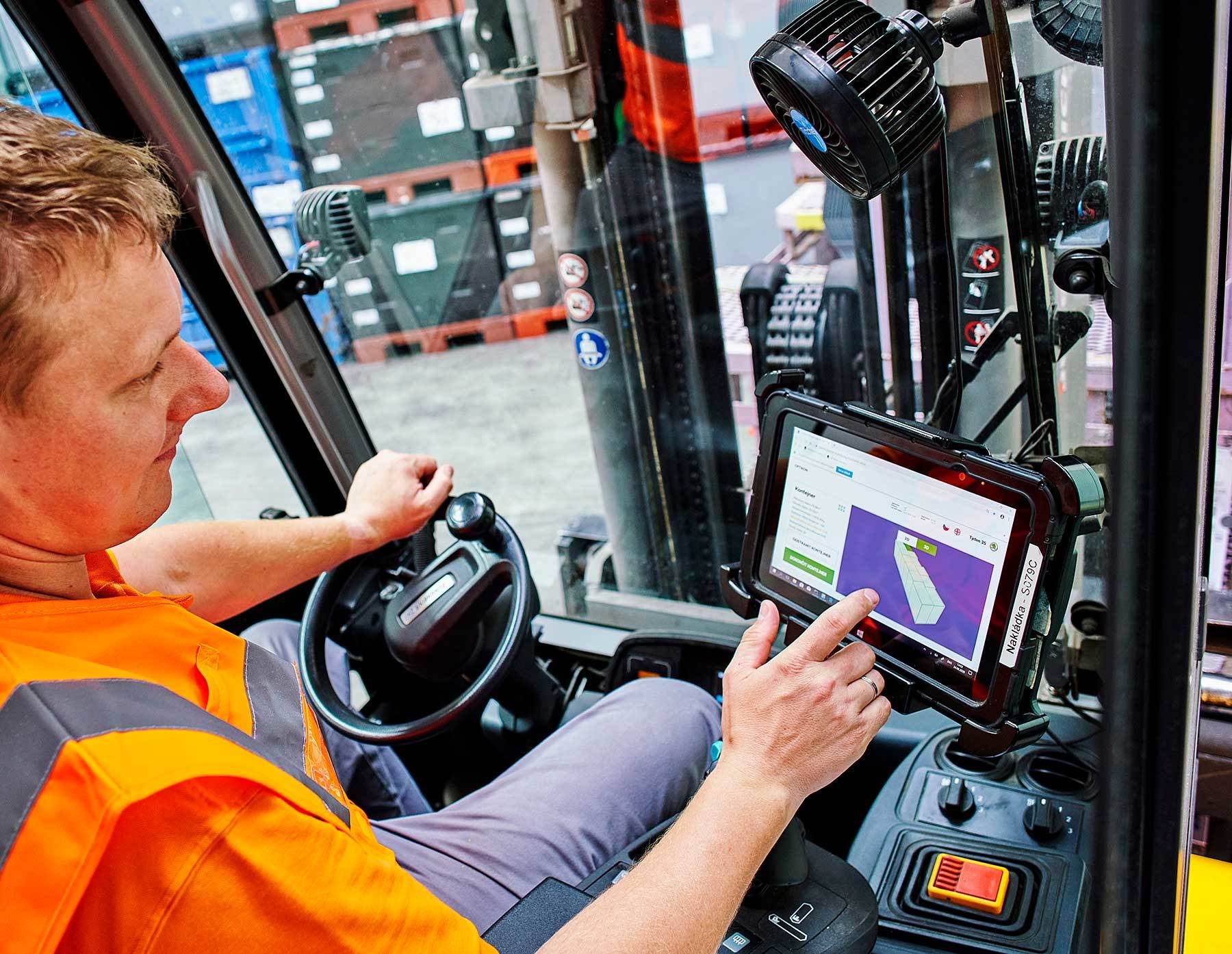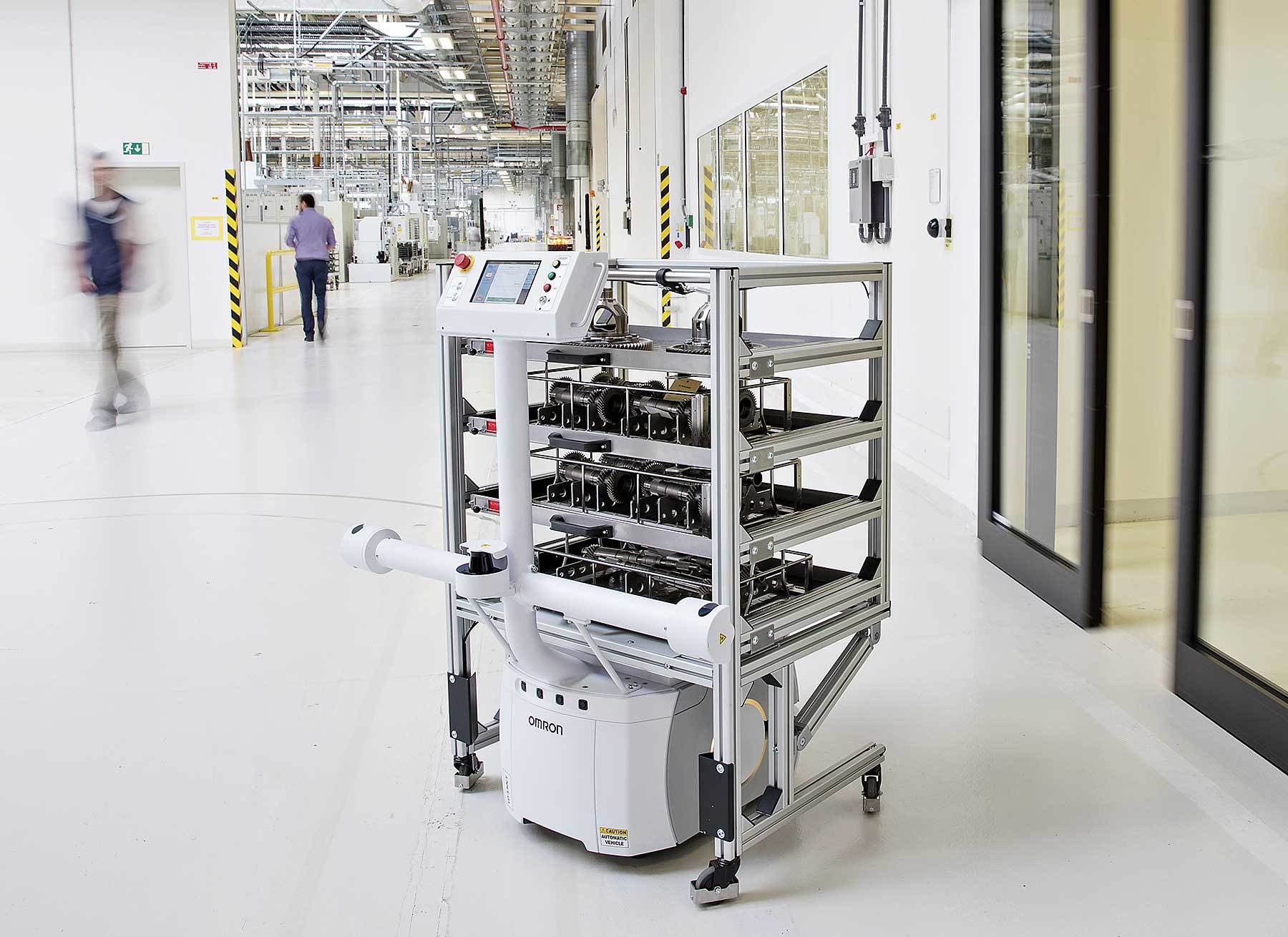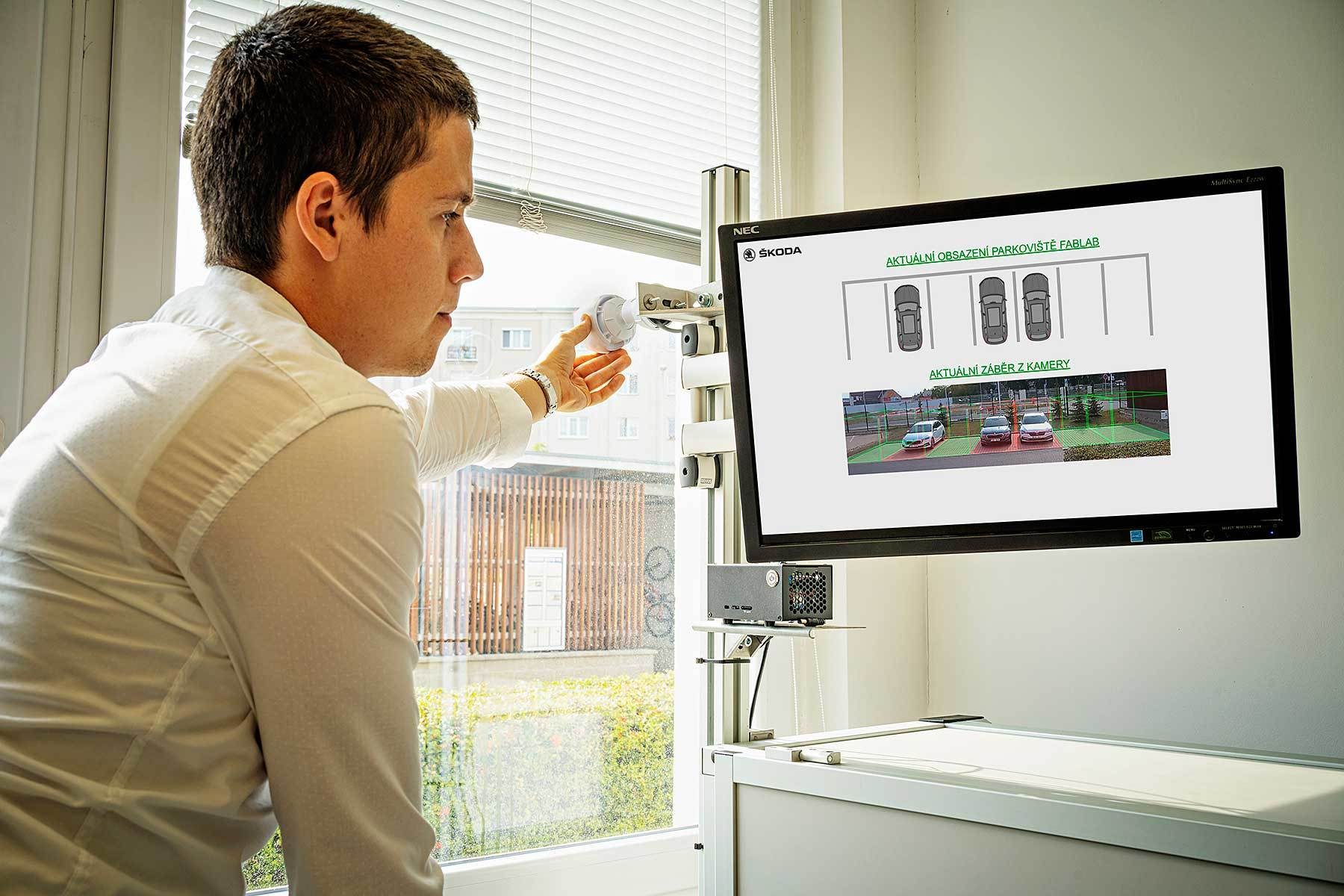
FACTORY OF THE FUTURE
John Sprovieri // Chief Editor
Digital twins, autonomous mobile robots and AI are some of the cutting-edge technologies helping European automaker Škoda compete.
Industry 4.0
at Škoda
John Sprovieri // Chief Editor
Digital twins, autonomous mobile robots and AI are some of the cutting-edge technologies helping European automaker Škoda compete.
Industry 4.0
at Škoda
Engineers use digital twin technology to run simulations of new line configurations, evaluating different processes and scenarios without having to move a single machine.
Photo courtesy Škoda

Like many long-established car manufacturers, the company that would become Škoda Auto started in the early 1890s by making bicycles. Today, you won’t see velocipedes rolling off of Škoda assembly lines, but you just might see plug-in electric vehicles.
Now a wholly owned subsidiary of the Volkswagen Group, Škoda produced more than 800,000 vehicles last year, including some 49,000 EVs. Based in Mladá Boleslav, Czech Republic, Škoda has the second highest profit margin of all VW’s brands, behind only Porsche.
That sort of performance hasn’t occurred by accident. Over the past few years, Škoda has invested millions of dollars in state-of-the-art assembly technologies to increase productivity, improve worker safety, and decrease the company’s environmental footprint. As part of an overall Industry 4.0 strategy, the company has implemented additive manufacturing, artificial intelligence, augmented reality, autonomous mobile robots and other technology.
Digital Twin Helps Modify Assembly Line
Engineers use digital twin technology to run simulations of new line configurations, evaluating different processes and scenarios without having to move a single machine.
Photo courtesy Škoda
Adding a new workstation to an assembly line requires careful planning—especially if regular operations are expected to continue at the same time. When engineers at Škoda’s assembly plant in Vrchlabí, Czech Republic, wanted to integrate a new robot into a gearbox production line, the project was fully operational in just three weeks—thanks to digital twin technology.
Engineers used a digital twin of the line to run simulations of the new configuration, evaluating different processes and scenarios without having to move a single machine. Once engineers had optimized the line design and process, they were able to install the new robot with minimal disruption.
“Without Industry 4.0 technologies, we would not have been able to install the new robot workstation in this way,” says Christian Bleiel, head of component production at Škoda. “Due to a lack of space, it would not have been possible to set up the new unit next to the existing stations and test-run operations alongside regular production. The use of a digital twin…allowed us to create an extremely detailed virtual image of the plant, simulate processes and procedures, and seamlessly add to the production line.”
Škoda is using a large six-axis robot to pick batteries from pallets and send them to the assembly line in the exact sequence in which they are needed.
Photo courtesy Škoda
Within a cycle time of less than 30 seconds, the new workstation installs bearings into each gearbox. Robots install the bearings to meet the precision requirements of the application.
To create the digital twin, engineers used a 3D model of the line. This included digital clones of the robots, sensors and safety components. This allowed all mechanical and kinematic processes at the station to be realistically simulated. The software aspect of the twin ensures smooth communication between all hardware components and the program-based control sequences on the line.
Using this set-up, the technicians developed, tested and optimized the control electronics and determined the space required for the new workstation. They were also able to calculate the ideal cycle time and prevent any chance of the robot arms colliding.
The model enabled engineers to shorten the time required to bring the project to an operational level by about three weeks. In addition, engineers saved approximately 40 square meters of floor space by optimizing the layout in advance. With the digital twin, the robot’s control programs were also developed before the robot and its peripherals were even in the factory.
Robot Picks Batteries in Sequence

Logistics personnel at Škoda rely on an app that uses AI to calculate how best to load shipping containers to maximize their capacity. The software enabled Škoda to save 151 container shipments in the first six months of 2020 alone.
Photo courtesy Škoda
At its assembly plant in Kvasiny, Czech Republic, Škoda is using a large six-axis robot to pick batteries from pallets and send them to the assembly line in the exact sequence in which they are needed. Škoda moved pick-to-sequence handling of parts from the warehouse to the assembly hall, which helped speed up production. Kvasiny is Škoda’s first site to adopt this logistics system, which has been in place since July 2020. Škoda invested some $469,000 to implement the process and has filed a patent application for the system.
“For parts to be delivered to the production line just in sequence, a range of highly complex processes need to operate in perfect harmony,” explains David Strnad, head of brand logistics at Škoda. “By using the new handling robot at the Kvasiny plant, we are optimizing this process, making production more efficient and thus even more precise and ultimately even faster. At the same time, we have increased workplace safety and ergonomics.”
In the past, batteries would have been stored in a warehouse next door, brought to the line via forklift, and then unloaded manually. Now, batteries are stored on pallets near the assembly line. To ensure the right battery is installed in the right vehicle, the robot scans a code on each battery using a special camera. It then puts the batteries on transport trolleys that carry them directly to the assembly line. The robot also stacks empty pallets and transport packaging, and can order new pallets containing batteries from the warehouse when required. The robot is mounted to a long linear axis, enabling it to pick batteries from multiple pallets in a row. Safety guarding and sensors prevent collisions with staff or machinery.
Plans call for the automaker to replicate the system to handle other heavy, high-volume parts.
Škoda is also testing another new concept at Kvasiny that is intended to increase work safety at the plant: Each forklift has been fitted with a tracking system so that the machines can identify other forklifts nearby at an early stage. Workers at the plant wear a special wristband that works using the same principle and alerts its wearer to dangers by vibrating. If the tracking system detects nearby forklifts or employees, the machines automatically reduce their speed and, if required, automatically come to a halt to prevent a collision. An LED light fitted on each of the forklifts also provides information about the density of potential sources of danger in the immediate vicinity.
AI Maximizes Container Loading

This autonomous mobile robot can transport a load of up to 130 kilograms. The robot only needs to be guided between stations once to learn its route. It automatically adjusts its path based on changes to its surroundings.
Photo courtesy Škoda
As one of the cornerstones of Škoda’s Strategy 2025, artificial intelligence is playing a key role in the carmaker’s digitalization process. AI is being applied not only to products and processes, but also to services to help make the customer experience more personal.
One area where Škoda is applying AI is in logistics. Remember the classic computer game Tetris? The aim is to drop differently shaped pieces into a given space without leaving any gaps. Škoda’s logisticians face a similar task when loading 40-foot shipping containers. However, they are now supported by Optikon, an app that uses AI to calculate how best to load shipping containers to maximize their capacity. The software enabled Škoda to save 151 container shipments and 80 tons of CO2 emissions in the first six months of 2020 alone.
“This AI app is a major development step on our way to digitalizing logistics and our work processes,” says Strnad. “The Optikon project makes the work of the employees in the parts warehouse easier while also lowering our transport costs. Furthermore, it has allowed us to reduce CO2 emissions because we only dispatch full containers now.”
There is an endless number of ways to fit the different-sized pallets into a container, which makes loading a challenging task for logisticians. This is made even trickier because, each day, the pallets available for dispatch in the warehouse are different sizes. The Optikon app, which was jointly developed by Škoda’s logistics and IT departments, helps to master this challenge using AI. The program calculates how the different pallets must be loaded to make maximum use of each container’s capacity.

At Škoda’s assembly plant in Vrchlabí, autonomous mobile robots deliver raw materials and supplies to CNC production lines. All materials are ordered automatically.
Photo courtesy Škoda
“Optikon illustrates how we use Industry 4.0 and artificial intelligence technologies at Škoda to make everything we do even more efficient,” says Klaus Blüm, head of IT at Škoda. “When determining how items should be placed to maximize container space, the app includes up to 400 pallet types in its calculations. The program also balances the weight distribution within the container and checks that the freight will be shipped in good time.”
The logistics department has been using Optikon since November 2019, in particular for loading containers that are shipped to Škoda’s assembly plant in Nizhny Novgorod, Russia. In addition to body components, production materials, such as adhesives, are also shipped to Russia from the carmaker’s warehouse in Mladá Boleslav.
Optikon uses mathematical combinatorial analysis methods to find various solutions to what is known as the “knapsack problem.” It addresses the question of how certain objects can be optimally fitted into a limited space. While the classic knapsack problem only takes into account the weight and value of the items to be packed, Optikon also considers floor space, the volume of the item, and when the goods have to be shipped.
Finding Use Cases for AI

Engineers at Škoda are working on ways to apply AI to predictive maintenance.
Photo courtesy Škoda
Container loading isn’t the only application that is benefitting from AI. Škoda’s FabLab, where the carmaker tests various Industry 4.0 technologies, is coming up with new applications every day.
For example, at the company’s assembly plant in Mladá Boleslav, AI is being used to coordinate truck traffic. Each day, approximately 2,200 trucks arrive at the plant to drop off supplies or pick up assemblies. AI helps to coordinate this traffic, ensuring just-in-time delivery and minimizing wait times for drivers.
Inside the plant, AI is being applied to predictive maintenance. “AI-based analysis makes it possible to detect anomalies in equipment before they become an issue,” says Miroslav Kroupa, head of brand management at Škoda. “This will provide us with more flexibility in terms of scheduling maintenance work and will prevent costly disruptions to production.”
For example, AI is being used to monitor the condition of bearings for skid conveyors. These large conveyors carry car bodies along part of the assembly line. Thermal cameras monitor the temperature of the conveyor’s ball bearings, which can jam. This allows engineers to proactively replace bearings that are nearing the end of their lifespan. The system also draws on data from the electric motors that power the skids. When a bearing starts to chafe, the electric motor also runs less smoothly.
Similarly, engineers are using AI to analyze the sounds a machine makes. “Every machine emits characteristic sounds that can be studied by artificial intelligence. When the monitoring detects an unexpected new sound, it informs the user that something is up,” says Milan Dědek, an expert in the use of AI in predictive maintenance. “This makes it possible to detect possible faults before they do any damage. For example, when ball bearings start to jam or gears become worn out, the machine’s sound changes slightly. A human can’t hear it, but AI can.”
Autonomous Mobile Robots Transport Parts

When ball bearings start to jam or gears become worn out, a machine’s sound changes slightly. Engineers can use AI to detect these changes and recommend maintenance before a machine breaks down.
Photo courtesy Škoda
Škoda uses fully autonomous, self-learning robots to transport parts at its assembly plant in Vrchlabí.
The robot can carry up to 130 kilograms. Unlike traditional automated transport systems, the robot does not require lane guidance in the form of induction loops, magnetic strips or reflectors. To learn the route, the vehicle only needs to be guided between destinations once via a tablet or joystick. In doing so, it captures its environment and notes changes to its surroundings by itself. It then automatically adapts its route if necessary.
Using sensors and laser scanners, the robot recognizes vehicles, stationary obstacles and people crossing its path. The control system calculates the approach speed and detects if a collision is imminent. In this case, the robot stops by itself or takes evasive action. The robot immediately adjusts its route based on information from its surroundings, without having to stop in the process. If the fully autonomous robot detects that it will regularly encounter obstacles at a specific point along its journey, it changes its route permanently. If necessary, the robot can travel to any location at the Vrchlabí plant, which covers 16,000 square meters.
The first application for the robot was to transport newly machined parts from the plant’s CNC processing lines to the metrology center. The robot completes 120 trips per day and travels a total distance of 35 kilometers on its route.
Now, autonomous mobile robots are also used to deliver raw materials and supplies to the CNC machines. The supplies are ordered automatically. At the warehouse, logistics employees place the supplies into a carrier. The robot then picks up the carrier and takes it to one of the CNC lines. On its return journey, the robot takes an empty carrier with it and automatically reports back to the parts warehouse.
The robots have increased productivity and safety at the plant. Logisticians are no longer required to enter production areas, because all components are transported to the CNC lines automatically. Since the CNC machines are supplied with more than 50,000 parts per day, the cost of automated transport is expected to be covered in less than three years.
ASSEMBLY ONLINE
For more information on manufacturing at Škoda, visit www.assemblymag.com to read these articles:
Roller Conveyor Moves Axles on Skoda Assembly Line
Robot Automatically Assembles Transmission With High Precision
FACTORY OF THE FUTURE JUNE 2022

Scroll to
read full story
Scroll to
read full article
LEARN TO NAVIGATE OUR eMAGAZINE
TOC
ASSEMBLY JUNE EDITION